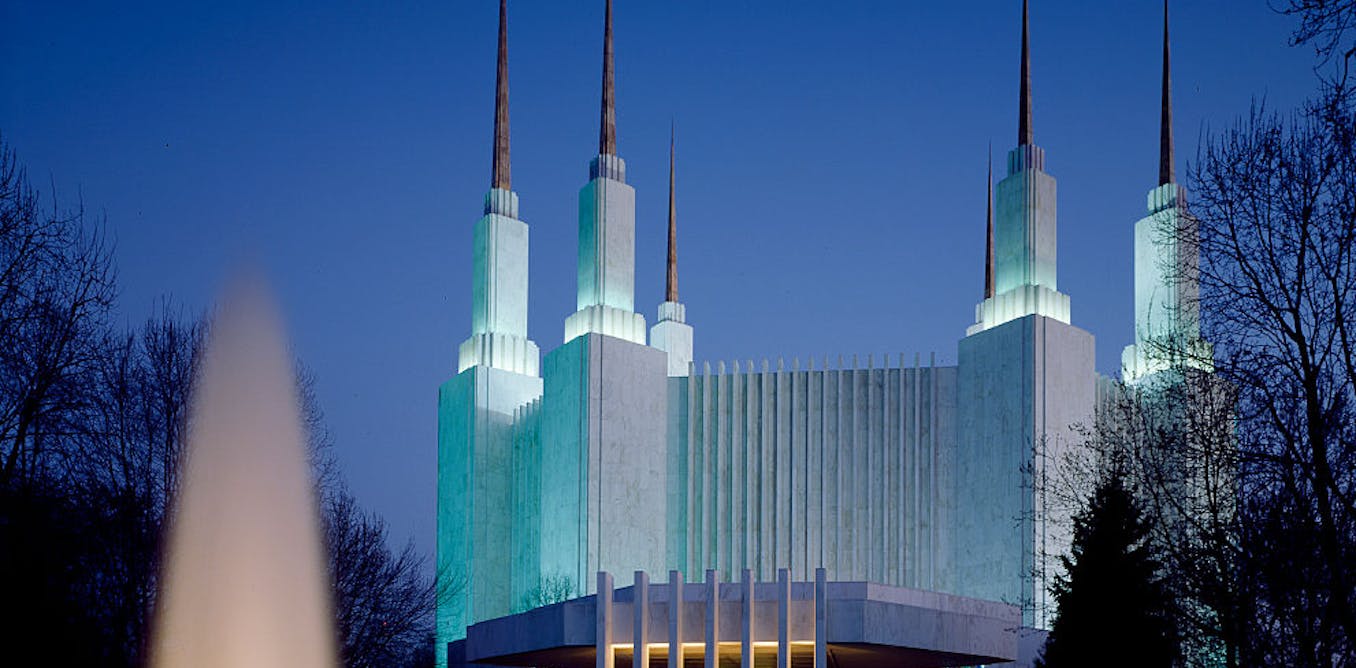The temples of The Church of Jesus Christ of Latter-day Saints, often referred to as the Mormon Church, have long been a site of curiosity, suspicion, and admiration. Grandiose, sometimes even imposing structures, temples are among the most distinctive symbols of the church.
Temples are where the most sacred rites or “ordinances” of the faith are performed, so church members have traditionally been taught not to discuss them publicly. But Latter-day Saint leaders have worked to clear up confusion about temples by posting photographs of the interior, describing the rites in more detail, and encouraging public tours. Many locations include adjacent “visitor centers” that offer a brief introduction to temple and church teachings, and new or renovated temples are open to the public before being dedicated for worship.
The LDS Temple in Washington, DC, for example – the tallest of faiths and a common landmark for commuters to the US capital – will be open for tours from April 28 to June 11, 2022, after four years of renovations.
Once a temple is used for religious rituals, however, entry is limited to church members who hold what is called a “temple recommend”: a document from local religious leaders attesting that the member of the church is in order. So what’s going on inside?
Not just “church”
Temples are different from churches in the faith of the Latter-day Saints. Weekly Sunday services are held in “meeting houses”, where members of the congregation teach religious lessons and celebrate communion, which they call “the sacrament”. Churches also host other events for the local LDS community.
There are tens of thousands of such meeting places around the world, which are open to the public and usually display a “Visitor Welcome” sign. They are simpler and smaller buildings that resemble other Christian churches.
In contrast, temples are rarer and considered much more sacred. There are currently 170 operational temples around the world, on every continent except Antarctica. Temples are closed on Sundays.
tiaramaio/RooM via Getty Images
holy covenants
As a scholar and historian of Mormonism, I can confirm that temples have long been a source of controversy – even in 1903, when the election of a prominent Latter-day Saint to the United States Senate sparked a government inquiry of several years. Critics have argued, unsuccessfully, that the vows Latter-day Saints make in temples should disqualify them from office.
Over the past century, temples have continued to attract public attention, usually when a local community opposes plans to build a new one.
The three main rites that take place inside are weddings, called “sealings”; the “Endowment,” which reenacts the Bible’s creation story; and “baptisms for the dead”. In this ritual, also called proxy baptism, church members replace those who died without having received an LDS baptism. Latter-day Saints believe that the deceased person has a choice in the afterlife to accept or refuse baptism.
Latter-day Saints often experience these rites as deeply transformative and learn that they have eternal consequences. In marriage sealings, for example, Latter-day Saints believe they connect with a spouse not only for life on earth, but also forever in the hereafter, although divorce is permitted.
During the endowment rite, which many adult Latter-day Saints participate in, members make a vow to serve God and others and receive instruction on salvation. Those who have received the endowment ritual also promise to wear a sacred “vestment” under their usual clothes.
Some members find the rites esoteric, strange or outdated. But most return again and again to absorb the symbolism and seek answers to prayer.
the house of god
Outside, the temples feature a variety of styles ranging from Gothic to Modernist. Today, most have a prominent steeple with a golden trumpet-blowing angel: the Angel Moroni. Moroni has a central role in the church’s narrative, as a prophet in the Book of Mormon who appeared to modern church founder Joseph Smith.

AP Photo/Rick Bowmer
Inside, each of the rituals has one or more separate rooms. The baptisms of the dead are celebrated in the basement in a large font on the backs of 12 oxen. The sealing rites are performed in smaller rooms with a central altar before which a couple kneels when they marry.
The endowment is the most elaborate. Participants are seated in a small theatre, with men and women on either side, to watch a film that depicts a sacred drama of Adam and Eve. At the end, all are admitted together to pray and converse in an elegant room called the “heavenly room”, the most sacred room, which represents the presence of God.
lightning rods
The rites have often raised debates. Strangers are excluded, which means that even immediate family members may not be present at a loved one’s wedding ceremony. Same-sex couples are excluded from sealings. Prior to 1978, black members of the church were prohibited from participating in any of the rites. Latter-day Saint feminists have criticized some of the endowment vows for strengthening the gender hierarchy, though some have welcomed changes made by the church in 2019.
Baptisms for the dead have also drawn criticism. Zealous church members have used genealogical records to perform baptisms for the dead for Holocaust victims, which Jewish groups have condemned as disrespectful of the victims’ faith. Church leaders have implemented controls to discourage the practice, such as urging members to focus on their own ancestors.
[Explore the intersection of faith, politics, arts and culture. Sign up for This Week in Religion.]
Yet temples also brought inspiration, and not just to adherents. The late Lutheran theologian Krister Stendahl once applied his famous idea of having a “holy urge” or admiring aspects of other religions, to describe his own appreciation of Mormon temples.
As sacred sites where members of The Church of Jesus Christ of Latter-day Saints engage in distinct practices, temples are sure to elicit diverse responses for years to come, especially as the Church continues its ambitious project to build more.

